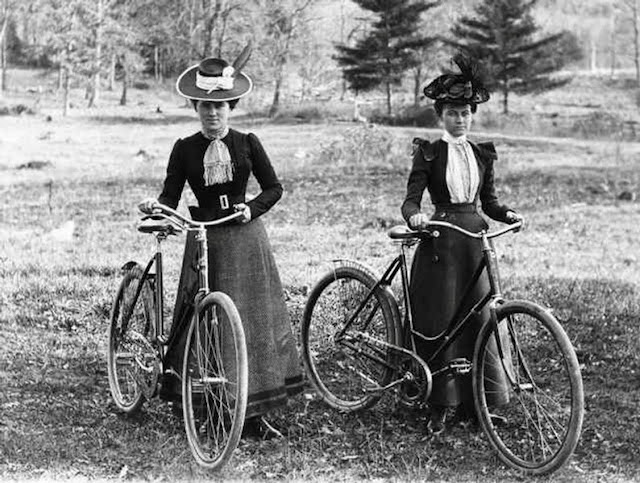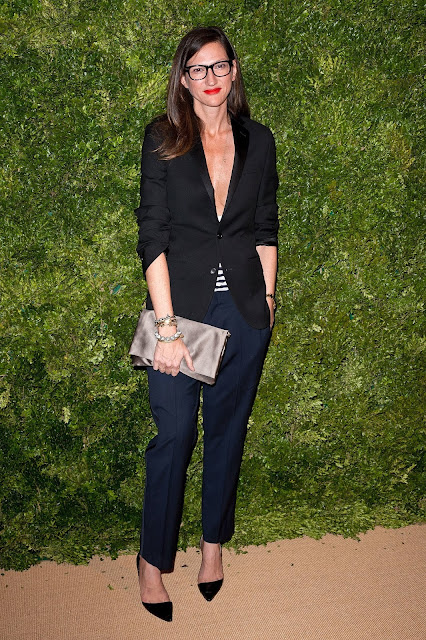When we hear the term “power suit,” images of 1980s female executives charging into the boardroom with broad shoulders enhanced by shoulder pads quickly come to mind.
However, the history of the power suit and power dressing started well before Melanie Griffith cemented the iconic image in her role as Tess in the 1988 film “Working Girl.”
However, the history of the power suit and power dressing started well before Melanie Griffith cemented the iconic image in her role as Tess in the 1988 film “Working Girl.”
At the turn of the century, i.e. the late 1800s and into the early 1900s, the bicycle made its debut. Before a Victorian lady could hop on and pedal to the nearest park or friend’s home, women’s fashion had to make a few adjustments. Bustles, lace and layers of fabric were no longer realistic for this new form of transportation and other growing options of leisure activities. Comfort soon entered the equation for clothing choices, coinciding with the bicycle’s appearance, as well as the New Woman. New types of tailoring appeared, as well as clothing pieces like bloomers and button down blouses.
These changes in acceptable wardrobe laid the foundation for the New Woman and future generations to find their voice outside of the home and select clothing that supported their changing roles. As more women entered the workforce during World War I, changes continued in women’s fashion including shorter hemlines, less fabric and separate work-wear.
By the 1920s, Coco Chanel introduced what would become the first true power suit. The first iterations of the suit were tweed with a fitted skirt, tailored jacket and masculine inspired hardware as modeled by the designer herself in the above photo. The style continues to be a part of Chanel collections each season and is a recognized style in offices around the world even today.
What made this design a power suit in the 1920s? For one, the skirt and jacket were fitted in a way that hugged the female form. This was a big change from even the athletically designed skirts of the early 1900s since they still had a lot of volume, layers (including bloomers) and full coverage. Women choosing to wear the suit were no longer confined by the heavy fabric and corset of early styles. The jacket was another factor in considering it a powerful way to dress. The jacket and buttons were taken from the man’s closet but adapted for a woman to wear. Walking into an office, event or function, a woman could wear the suit without constraint so that she could move in a confident and natural manner.
Updates to the suit continued through the early and mid-20th century, including the introduction of the pants worn by famous women like Katherine Hepburn. The first power suit with tailored pants was created by Yves Saint Laurent and called “Le Smoking” and is pictured above. Who could resist a woman in a masculine inspired suit that spoke of power (once considered a male-owned trait) and femininity?
By the 1980s, women embraced what would become the now classic version of the power suit. Women were entering the corporate world in greater numbers, and thus a new wardrobe was required. Designers like Giorgio Armani, Ralph Lauren, Anne Klein and Donna Karan offered women power suits with pant and skirt options. With shoulder pads creating strong shoulders and jackets with straight lines, women walked into the boardroom with a no-nonsense appearance. The suits took cues from the masculine closet to offer a sense of empowerment and credibility.
There have been times since the 80s that the power suit has been declared over and unnecessary. It’s true that a jacket will not make you more powerful or that you need shoulder pads to be taken seriously. However, the power suit has not disappeared, it has merely evolved.
Now more than ever before in history, women are using their positions to make change. They’re joining men in the highest levels of the education system, taking part in the political arena, running major corporations, successfully managing households, creating new works of art, pushing the boundaries of sports and more.
Michelle Obama, Former First Lady, activist and author via Harper's Bazaar
Jenna Lyons, Former J. Crew Creative Director via Vogue
Amal Clooney, Human Rights Attorney via PopSugar
As leaders across a wide variety of platforms, the power suit of choice may be different from the original definition. A Chanel tweed suit may still be the preferred choice for some women, while others choose a jacket with jeans and leopard print heels or yoga pants and a tank top. We are no longer limited to a single definition of powerful style. Instead, we can embrace what clothing pieces make us feel confident and authentic to help prepare us for whatever dream, task or opportunity we are pursuing.
Duchess Kate Middleton via The Telegraph UK
Sources and Further Reading:
Chanel Spring 2019 Couture Images via Vogue
CR Fashionbook "History of the Chanel Tweed Suit"
Designer Vintage "History of the Power Suit"
Refinery29 "How the Bicycle Liberated Victorian Women and Kickstarted American Feminism"
The Wall Street Journal "The Leaner, Meaner Power Suit"
Women's Museum of California "Rise of the Power Suit"























